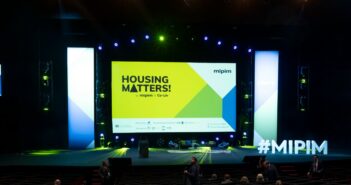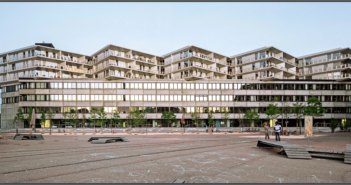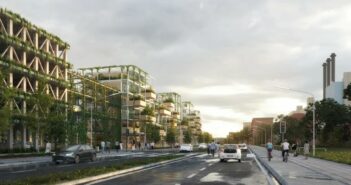Leasing & Occupancy
New office building developments are incorporating a tremendous number of new features to make tenants happy and entice them to stay longer. In 2025 75% of tenants in office buildings will be millennials.[1] Developers understand that these millennials want different functionality and have different expectations from their work place compared to the past group of baby boomers. Millennials want to see workspace integration flexibility, collaboration space, wellness space, with total connectivity to various, teams, communities or the public.
Employees want work/life aspects integrated within their work environment. Workspace must be as appealing as all the alternatives including home space. This ability to make employees/tenants feel comfortable at work, and not as if they are missing out on family life and other aspects outside work, greatly helps to increase productivity. A productive workforce is a happy workforce, which leads to a thriving company, which translates into tenants staying long term, which makes landlords happy.
WeWork is a company which rents short term work space for individuals or multiple employees. One can rent spaces monthly or even hourly. WeWork has state of the art facilities, but what they are providing most of all is flexibility and an environment that keeps occupants happy. Small time start-ups (mainly Millennials) love the idea of not having to sign a long-term lease. WeWork’s strategy is now becoming more universally applied within single tenant space and one question is whether landlords could do this themselves.
Rick Caruso, CEO of Caruso Affiliated, uses the term, “the second shift” which refers to all the things employees cannot get done during work; for example: laundry, vacation booking, grocery shopping, refueling cars, the list goes on and on. But Caruso has decided to bring a concierge service to his properties directly and not through a third party vendor. This service will help to take care of all non-work related aspects that employees worry about while in the work environment. By providing a service which helps to take care of these “second shift” to-do list items, companies can greatly increase employee productivity. Caruso hired a third party survey service to evaluate the value of such services. The conclusion was that a concierge services generates on average an extra 100 minutes of productive work time per employee per week. Concierge services may seem like an expense to landlords/companies, but they provide huge dividends to the happiness and productivity of their employees.
Collaboration in the work environment draws to mind Silicone Valley tech firms; think Google, Facebook, Dropbox. These companies have allowed their employees to interact in an open space environment, with few designated work spaces. This flexibility allows for the sharing of ideas, a community type feel, and a productive work environment even though if it is a culture shock for old guys. Now tenants also understand that sharing space allows the same productivity with less workspace and less cost per employee. In the U.S. an average workspace is only occupied 51% of the time during the normal work week (Monday to Friday 9am to 5pm).[1] This means there is a huge underutilization of space in the commercial office space. Giving employees the freedom to work at any workstation they choose saves a tremendous amount of space per employee.
The Edge, Deloitte’s newest commercial office building in Amsterdam has taken workspace utilization to the highest level. Employees have a smartphone app which is completely integrated with the building. This means the building knows which workspaces are available and coordinates this with each employees’ daily schedule via the app. This means if an employee needs a conference room for a meeting The Edge has already booked and prepared the designated room for said employee. The employee can also customize their workspace setting in terms of temperature, and lighting. Imagine presetting your ideal lighting conditions for a presentation and as you enter the room the lights are automatically dimmed to that setting. The Edge is a truly new age building, not to mention it has a BREEAM rating of 98.4%, the highest score ever! All of these factors add up to less square footage needed per employee, resulting in a huge cost savings for tenants.
Office buildings of the future need to be equipped to accommodate more of the needs of the tenants, even if personal in nature. The concept of wellness promotion is fairly new. More and more companies are steering towards space providing a healthy and wellbeing environment for their employees. Companies want their employees to have access to gyms/fitness, healthy eating, relaxation space, and anything else which will keep the employees happy and on-site. Google, Dropbox, and footwear company Zappos all have office properties which incorporate fitness centers, top quality cafeteria eating, and nap rooms. Dropbox employees rave about the companies onsite cafeteria. The cafeteria is broken up into multiple sections such as the sushi bar, make your own smoothie bar, and many different cuisines of the world, all prepared fresh daily by onsite chefs.
Millennials also want peer to peer interaction and an overall sense of community in the office. The new generation of gen Y-ers want the workplace to be inviting and feel as if they are working towards a collaborative goal with a team. Peer to peer interaction starts with more open space, which again translates in to less square footage needed per employee. CBRE’s San Diego office is currently in the process of building a new office building adjacent to a high end regional shopping mall with lots of walkable restaurants. The new office will be 32,000 square feet, downsized from the current space of 33,700 square feet but hosts 25% more workers. In the new office, each employee will require no more than 156 square feet compared to 217 square feet in the old space. CBRE’s current office is two floors. The new one will be one floor.[1] Paul Komadina, the Managing Director of CBRE San Diego explains, “that having two floors at the old office always felt like CBRE was two different companies. Employees on one floor would never interact with employees on another floor.” One floor provides an environment allowing for a much greater sense of community.
The office building services and layout of the future is very different from the past.
Employees want a sense of belonging and to feel as if they are making a difference in their company. All in all, they want to strike a healthy work/life balance and to treat the workplace as one of their important communities. It is up to landlords to address the new-age demands of millennials and tenants, and they will need to do all this while using less space per worker
[1] “Evolution of the Workplace a Tenant’s Perspective” Paul Komadina Managing Director of CBRE San Diego
Source: Getty Images



